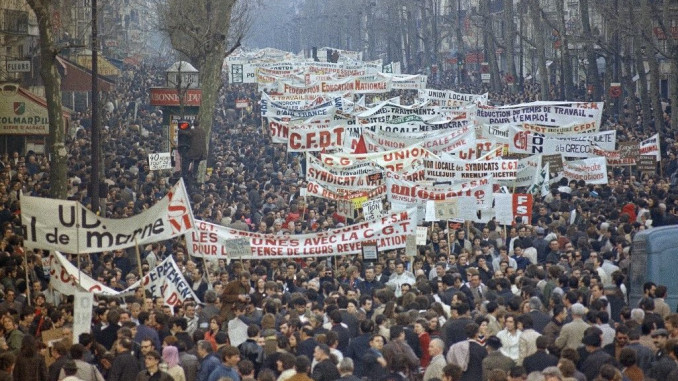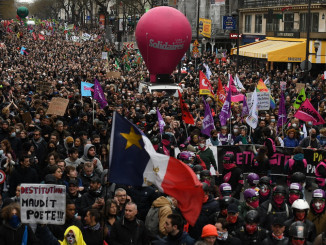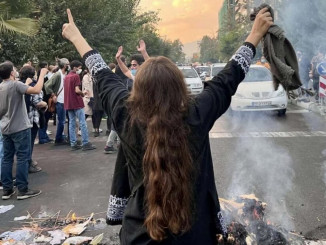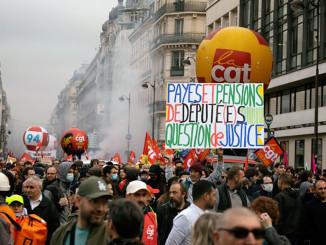
Part of this article is extracted from the pamphlet, “1968 – Be Realistic, Demand the Impossible” published by Speak Out Now.
Fifty-five years ago, an explosive social movement burst on the scene in May of 1968 in France. This was a mobilization that was both intimately linked to and fed by a world-wide movement. In the wake of the anticolonial wars of liberation after World War II, a generation of youth had as its idols the revolutionaries who fought against imperialism. In the 60’s the night time news of the day was crowded with images of imperialist war, with its carpet bombing, attacks with napalm, and civilian massacres by U.S. forces in Vietnam, which was a former French colony.
One aspect of the movement in France began with a protest in Nanterre, a suburb of Paris, at a brand new university campus. Some of the students there were organized in small groups of what were then called the “extreme left.” These Trotskyists, anarchists, and Maoists mobilized passionately against the U.S. war in Vietnam. Among them, six demonstrators were arrested on March 20 after a few stones were thrown against the windows of the American Express headquarters in Paris. To protest the arrests, the students of Nanterre occupied the administrative tower of the university. They were expelled and the campus shut down, which gave the students an excellent reason to join students of the major University in Paris, the Sorbonne. The student revolt had begun, rising with all its might against the police force of the French state, which was led by President Charles de Gaulle. But these students weren’t alone. They were joined by long-simmering angry workers, and together this movement was to shake this power to its core.
Solidarity between Workers and Students in the Lead-up to ’68
In January of the same year, workers at Saviem, a large truck factory in the city of Caen, went on strike. They demanded a wage increase, and the strike spread to other local factories. Clashes ensued between the police and the workers, who were joined by students. This lasted the whole month. It was a dress rehearsal for May, begun by young workers.
In fact, we can even see roots of May ’68 in 1967, when France experienced intense social unrest. In February ’67, workers at Dassault, an airplane manufacturing factory in Bordeaux, occupied their workplace. The same thing occurred in textile factories in the eastern and northeastern regions of France. Each time, a workers’ procession, often joined by students, fought with the police. Young workers were at the lead, their pockets full of bolts to respond to tear gas from the cops. At the same time, in Normandy and in Brittany, farmers rebelled. In October 1967, some 20,000 farmers marched through the streets of Quimper, some holding a portrait of the Cuban revolutionary, Che Guevara. Dozens of protesters and policemen were wounded. The same occurred 300 kilometers away in Le Mans, where 6,000 farmers assaulted the administrative offices of the police. At this point the workers of the region joined the protests. This was not really surprising, as workers in these regions came from rural families. Very often students joined the workers and farmers. The local police chief reported to the Minister of Home Affairs that they were experiencing the “rehearsal of a Revolution.” This was still several months before the events of May ’68.
From Student Barricades to the General Strike
Solidarity between students and workers was therefore already developing. In May of ’68, students occupied the Sorbonne University. The government sent the police to expel them, and arrested more than 500 people. In response, two thousand young people swarmed the streets of the lively neighborhood of the Sorbonne University known as the Latin Quarter, clashing with the police and shouting the slogan, “libérez nos camarades!” (“Free our comrades!”). Then high school students joined the protests and there were more street clashes with the police. The student movement grew, following what was later called the “nuit des barricades” (“night of the barricades”) on May 10 and 11. The following morning, 400 more people were arrested. The public was outraged at the extent of the repression.
Public opinion quickly shifted in favor of the students. The teachers’ unions and other workers’ unions, siding with the main student union, called for a demonstration to take place on Monday, May 13, to protest the repression. To everyone’s surprise, an immense crowd of around 500,000 people overran the streets of Paris. Huge demonstrations also took place in different cities all across the country. Among the most common slogans was: “Ten Years is Enough,” which reflected the fact that President de Gaulle had been in power since 1958. The CGT (General Confederation of Labor), the most influential union at the time, was linked to the French Communist Party (CP), and reflected its conservatism. Yes, conservatism. That may sound strange but, after the consolidation of a powerful bureaucracy in the Soviet Union decades earlier, the French CP ceased being a force fighting for international workers’ revolution.
Up to that point, the CGT had not sided with the movement and had denounced the protesters as “leftists.” When the CGT called for a one-day strike on May 13, its leadership intended it to be a purely symbolic action and hoped to bring the confrontations to an end. History decided otherwise.
The next day, the workers of Sud-Aviation in Brittany went on strike and occupied their factory, thanks to the initiative of a Trotskyist activist from the Internationalist Workers Party. They formed a strike committee despite fierce opposition from the CGT militants. The strike expanded quickly to the factories of Renault Cléon in Normandy. Step by step, the rank and file spread the movement to the whole country. It became a general strike with 7 million workers participating, and it lasted for more than a month.
The Politics of the French Communist Party and of the CGT
The Stalinist French Communist Party was completely overwhelmed by the student protests. It had not ceased denouncing “leftist” students, calling them “the offspring of the bourgeoisie”, or “daddy’s boys.” They even went as far as to call the student leader of Nanterre, Daniel Cohn-Bendit, a “German anarchist.” Others also attacked him for being Jewish. Hence the slogan in student demonstrations in May: “We are all German Jews!”
When they finally realized that the strikes were generalizing, the Communist Party and the CGT became afraid that rank-and-file workers would bypass their leadership entirely, and they would lose credibility. This is why the CGT, which never explicitly called for a general strike, chose to join the movement — to try to control it.
CGT militants therefore went along with the movement of factory occupations, but in their own way: the objective, as they put it, was to maintain good order in the factory, to “protect the tools,” to maintain discipline, and to be “responsible.” In a number of big factories (such as Renault Billancourt near Paris, with 30,000 workers), they encouraged the workers to strike by staying home, coming to their workplace only to attend general assemblies, where they could receive the union’s updates. They asked the workers to trust union delegates to manage the factory occupation. This meant that they hunted dissenters, and they prevented the students from joining the workers and making contact with those who were on strike. As a result, in a number of sectors, young workers and employees deserted their workplaces to join the student demonstrations, and to make contact with extreme left groups.
May 27: The “Grenelle Agreements”
The CGT’s objective was to put a quick end to the general strike, by negotiating with the employers and with the government. These negotiations took place at the Ministry of Labor on Grenelle Street in Paris. The result of these agreements was a general 10% increase in salaries and, more importantly, the creation of “Workplace Union Sections.” This was a gift to the union bureaucracies; it provided each union in the workplace with a hall, as well as paid hours for stewards who were chosen without even having to run for election.
The General Secretary of the CGT, George Séguy, thought that the deal was settled, and went on to present the outcome of the negotiations to a general assembly of 10,000 workers in Renault Billancourt. However, when he announced that the employers refused to pay for the strike days, a wave of indignation rose from the audience, and he was booed by thousands of workers. This was a crucial moment in the struggle. It led the government to panic. If these “leaders” of the workers couldn’t control and contain the movement, if the general strike were to continue, the government could face a revolutionary situation.
De Gaulle Leaves … and then Returns
As a result of the failure of the Grenelle negotiations, on May 29 President de Gaulle canceled the meeting of the Council of Ministers and secretly flew off to Baden-Baden in Germany. He sought advice from General Massu, who had commanded French forces in the Battle of Algiers in 1957. De Gaulle wanted to verify whether the French army would be ready to take action in case a revolutionary situation developed.
For its part, the CGT looked for another way to control the movement. It did not immediately give the order to go back to work. What they did instead broke the movement apart, and weakened it. They encouraged workers to negotiate at the local level, company by company, in order to decide under what conditions work should be resumed. It meant that these negotiations took place in isolation from one another, without benefiting from the power that the general strike gave them. The strikes continued for at least three more weeks, until the end of June.
However, when they resumed work, many workers did so with a bitter taste in their mouth, and a feeling of anger.
When De Gaulle returned to France on May 30, he was a reassured man. He had the backing of General Massu, and he announced the dissolution of Parliament, meaning that new legislative elections would take place. Meanwhile, his supporters organized a massive, reactionary demonstration. Up to 300,000 members of the bourgeoisie and its middle-class supporters marched on the Champs-Elysées to back up the government.
The workers, however, were not impressed. Strikes went on until the end of June, despite the instructions of the CGT union to come to agreements. The bonds between students and workers strengthened.
The French Communist Party was happy to take part in De Gaulle’s electoral game, hoping this would restore order. Students and workers, on the other hand, preferred shouting “élections, piège à cons!” (Elections: a trap for asses!). And a trap for asses they were indeed. The reformist Communist and Socialist Parties didn’t win the elections, and ended up in the minority as the Party of De Gaulle got the majority of seats in the new Parliament.
The Extreme Left Organizations
The period led the small revolutionary organizations that existed to grow. Some French youth had become politicized and radicalized during the Algerian War, which ended in 1962 with the independence of Algeria. These young people had broken loose from the Socialist Party and the Stalinist Communist Party, and Trotskyist groups started gaining new activists. And in 1966 some youth left the Communist Party’s youth organization, Etudiants Communists, to give birth to the JCR, the Revolutionary Communist Youth. There were also groups such as the Lambertists who established themselves in the FO (Workers’ Force) union, and Voix Ouvrière (Workers’ Voice) was a small Trotskyist group. All of these groups grew. After 1968, Worker’s Voice became became Lutte Ouvrière, or Workers’ Struggle, and as a result of its growth it managed to gain a foothold in major factories around the country, using its local workers’ newsletters.
Even if the Communist Party and the CGT eventually managed to quell the general strike, the extreme left acquired a new audience not only among students, but also among the working class.
Revolutionaries were no longer marginal and instead established themselves firmly in the working class in the ensuing years. The extreme left organizations had not accounted for more than a hundred activists each before 1968. After ’68, these groups grew tenfold and each counted between 1,000 and 2,000 activists.
What to Make of it All?
The government and the right did win the elections. But the whole political and social scene was altered. From the 1970s on, the number of workers’ strikes increased, especially fights for wage increases. Some strikes were led by revolutionaries and organized by democratic strike committees of rank-and-file workers. Fifty-five years later, this achievement is still an inspiration, with important lessons for working class struggles taking place today.
Even now, as we watch the fight against raising the retirement age in France, and the fury against the government policy expressed by the majority of the French population, we can see how conservative union leaders in France are playing the same role as they did in ’68. They are spacing out the workers’ demonstrations and strikes, avoiding a general strike, leading the workers and other demonstrators back toward so-called “institutional” solutions that lead to a dead end by avoiding the deployment of workers’ power. In what ways? By appealing to a constitutional body created by the ruling class, or pushing for a referendum on the pension reform, which would require waiting another year. Anything but wielding the extraordinary power the workers have when they organize their fight together. Workers united can stop the economy, or reorganize it as they wish! This was the lesson of ‘68 that we need to remember today.




